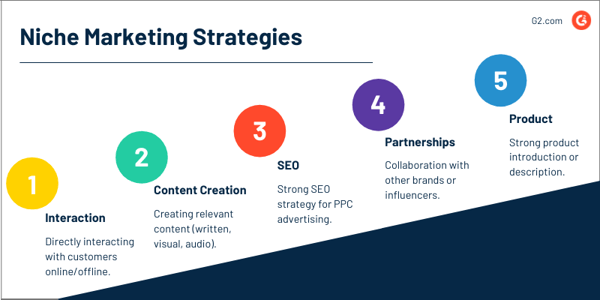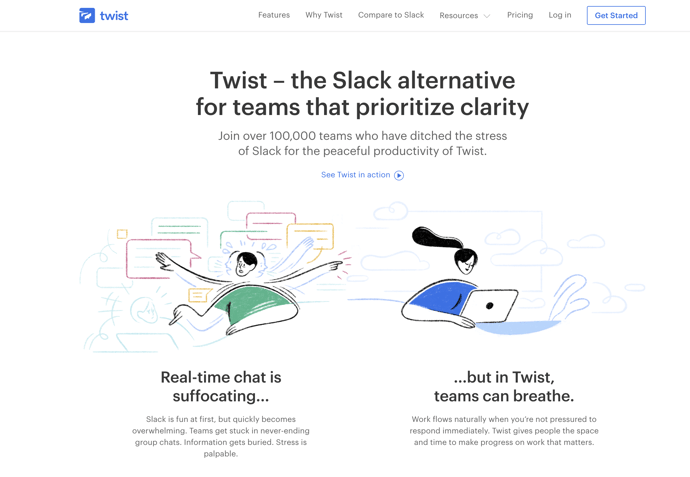March 24, 2021
 by Ninisha Pradhan / March 24, 2021
by Ninisha Pradhan / March 24, 2021

You can’t please everyone.
Today, if you want to purchase something, it’s not hard to find what you’re looking for online or offline. Most businesses fall under a commercialized space, which makes them and their competitors’ offerings extremely easy to locate and interact with. Whether you’re looking for retail goods, financial services, or even technology platforms, anything a customer might need is readily available.
On the other side of the spectrum, we have smaller businesses that offer products and services that are so unique, it’s hard to even imagine that there are consumers out there that are searching for them or willing to pay for them. Companies like Etsy have created a thriving business in spite of operating within a narrow segment of unconventional products.
How do these businesses attract their target audience when their line of products aren’t created for a broader customer base? Mass marketing strategies are too broad-based and will not work well for these kinds of businesses. Yet these businesses continue to see success in their particular niches.
The answer to this is niche marketing.
Niche marketing is a marketing strategy that focuses on specific segments of the target audience that share a common interest or pain point. In this strategy, marketing and advertising efforts become concentrated to serve a distinct subset – or niche – of the entire customer base.
When most people think about a market niche, they think of small indie brands that sell quirky items or novelty pieces. What they don’t realize is that niche marketing is an approach that large organizations can – and should – also adopt.
Customers differ from each other on the basis of demographics, region, and budget among other challenges. These customers could all be categorized under different groups. How the business communicates with each segment will have to differ from group to group.
Take a school for example.
Teachers offer the same service to all the students (teaching), but they wouldn’t be approaching a high school student the same way they would approach a preschooler. Here, age groups serve as a niche, and the way a teacher communicates with a student differs based on the age group they are interacting with.
Companies should take a page out of indie businesses when it comes to utilizing niche marketing strategies effectively. Niche marketing encourages companies to stand out from their competitors as an exclusive brand in its own right.
Tip: Gathering market intelligence can help businesses assess what their competition is doing.
You might be one of many software companies in a saturated market. By pursuing a niche, businesses can effectively view each segment within their target market comprehensively and launch marketing campaigns that resonate better with the audience. Since these marketing activities start catering to a specific niche, businesses are able to establish a deeper relationship with their customers and distinguish themselves from the crowd.
Adopting a niche marketing strategy is a great way for businesses of all sizes to develop a closer relationship with their customers. But how exactly do you find a niche for your business?
Let’s explore a few ways to find a niche that works for your organization.
%20(1).png?width=600&name=Opportunity%20analysis%20web%20(6)%20(1).png)
First, understand what your business’ offerings are, what the current messaging is, and how your product is different from your competitors.
Whether your business enjoys being a first-mover within the industry, or your business is grappling for a share in a crowded market, identifying what makes your business stand out can point you toward a niche worth pursuing.
Say you own a clothing store. After several months, you’ve noticed that your stock for plus-sized clothing runs out pretty quickly. As a result, you lose out on willing customers that are looking for a specific kind of clothing because you don’t carry enough inventory.
An immediate solution to this problem is to increase the stock of plus-size clothing.
Over time, you begin to see a huge demand in this space and decide to create more designs in this line. Soon, your store becomes synonymous with trendy apparel that is size-friendly. Essentially, you figured out a niche that your store could cater to, and you grow a segment of the audience that you had underserved in the past.
Niche marketing aims to emphasize the distinctive qualities of your business. It’s always good to take a step back and truly understand the strengths and weaknesses of your brand before you set out to market it to your customers.
By evaluating your company’s current offerings, you can answer several questions like:
Now that you’ve found a few niches that align well with your business, it’s time to check if they’re worth exploring. While a niche essentially implies something unique from the mass public, it’s important to make sure your ideas aren’t too novel that there isn’t even a market for it.
Researching the industry is a great way to get a feel of how the market beats, explore new opportunities, and understand which segments are being underserved. Here are a few ways to start your research process:
Google is everyone’s best friend.
There’s no better way to find out what your customers are looking for than by tracking keywords related to your niche. Internet users are quite specific with what they’re looking for, and as a result, their web searches can become extremely granular. This helps marketers not only assess whether the niche they’re looking at is worthwhile but also narrow down the messaging that would work best for these customers.
Let’s say your business offers a graphic design platform that has ready-to-use templates.
You’ve noticed that there are hits for “video thumbnails” over the past year. This sends out a clear message that there is a specific demand for ready-made templates. It’s a good opportunity for your business to create these templates and advertise the same across video streaming platforms.
Playing around with more iterations of a set of keywords gives you a broader picture of what customers in this segment are possibly looking for.
Going back to our earlier example, if we narrowed the keyword search even further to include popular platforms like YouTube and Instagram, we could see where there is a more pronounced demand for thumbnail templates for a particular platform. If more people were searching for templates to use on Instagram, it would make sense to create more assets incorporating Instagram features.
One key thing to note here is that since these keywords are centered around niche audiences, the keyword density for these will not be as high as those that cover a broader audience. The goal isn’t necessarily to see what ranks on the first page of a search engine but to see what niche products customers might be looking for.
Social media is the watering hole of the 21st century. It isn’t just for mainstream audiences anymore, it also houses numerous niche audiences that are forged by a specific need or issue. After doing keyword research, it’s a good idea to plug those keywords into popular social communities like Reddit, Quora, or Twitter. If people are searching about it, then people are talking about it.
Following popular threads or posts online can give insight into what these communities are saying. Not only do you get a customer’s opinion firsthand, but you also get ideas on how to make your product even better.
Imagine you have a skincare company. After combing through several communities, you realize that people with sensitive skin types suffer from hyperpigmentation. You then formulate a product specifically to combat this particular issue and for a specific skin type. Customers in this segment feel validated and are eager to buy a product that seems to be made just for them.
Social media platforms can also point out audiences you might not have factored in, but are present within the niche you’re looking at. Since the internet has become such a global phenomenon, people of all ages and different backgrounds are exposed to trends, online resources, and products.
These people float towards groups and communities that share similar experiences. If you only target a certain demographic, you might be missing out on people who have the exact same need or pain point but haven’t made it into your customer map.
Social media ultimately assembles customers in any part of the world in one place and allows businesses to hear directly from them.
Nothing gives you a better understanding of how the industry behaves currently than analyzing what your competitors are doing. Since your competitors and your business would share overlapping audiences, it’s a good idea to observe the differences in messaging and product features.
After assessing your competitors, you can detect gaps that your competitors fail to deliver, or don't have a solution for yet. You can also spot market opportunities that fall within the scope of your product capabilities but haven’t been explored yet. This can spark new product ideas that could be introduced within your lineup and present a few niches within a broader market that your business should be interacting with.
Niches are also a product of burgeoning trends. Any business worth their salt should be closely following market trends and emerging companies. One way to do this is by finding reports on specific categories within your industry.
Market reports catch emerging categories that provide solutions customers are interested in. Collecting data on these trends can also indicate whether the demand for such a solution is expected to grow, and by what percentage. This can give companies a lot of much-needed reassurance on whether it’s worth investing in a niche.
Fintech is a direct result of trends within the banking industry that paved the way for niche products to disrupt the space. Analyst reports have covered each segment extensively culminating in a tech-forward industry that has boomed over the past decade.
Pursuing a niche can be a huge advantage to businesses. Let’s take a look at some of the benefits associated with niche markets.
Niche marketing is great because your marketing will talk to customers instead of at them.
Customers want to feel seen and heard by brands. There’s nothing customers love more than feeling special. Because niche markets only cater to niche customers, the marketing message that is pushed out becomes razor focused.
Customers don’t have to deal with diluted messaging and the business is able to grab the attention of customers that have a much higher chance of converting, since they resonate extremely well with the digital marketing campaign.
Another bonus for marketers: not having to shell out extra money on campaign spend.
Because the audience size is already so low, marketers can spend most of their time on planning and executing creatives for a niche, rather than having to rack their brains on the number of dollars they’ve spent on low-converting campaigns.
Since the customer base is hyper-targeted, brands are able to build a stronger connection with their customers. Customers are more likely to continue with a brand that seems to cater to their personal needs. When potential customers align with a niche product or service, the business that offers it automatically stands out from the rest.
This instills a feeling of loyalty toward a brand and makes customers feel like they’ve stumbled onto something special. As a result, customers become brand advocates that stay on with a business for a long time.
If you’re working within a niche, your business is a big fish in a small pond. Businesses enter a space that isn’t widely explored and as a result, they face minimal competition when they start out in a niche market. This gives brands incentive to call the shots within that niche, grow and become a pioneer in that market.
Unlike mass marketing, where everyone is competing within an incredibly crowded space, with niche marketing businesses don't need to fight for market share. This gives brands the license to experiment without having to worry about making too many mistakes and other competitors with an overlapping customer base.
Common battles that sales and marketing teams have are over the quality of leads that get generated through marketing efforts. While mass marketing can boast quantity, the percentage of leads that actually move forward in each stage of the sales funnel is low.
With niche marketing, the leads that enter the funnel are of much higher quality. These are customers that are looking for a very specific requirement to be fulfilled and are willing to pay for it. Even though the number of leads that come from niche marketing is much lower than what you’d see from a mass marketing campaign, the number of interactions required with the customer before they convert is far less.
While niche markets offer businesses lucrative opportunities and a host of other benefits, there are a few drawbacks to niche markets. Let’s break down a few notable disadvantages that marketers operating in this space could encounter.
Niche markets by definition, are a small group. Since the total size is smaller and the market is more pronounced, the scope for growing and scaling operations within a niche becomes difficult.
That’s not to say that it isn’t possible. Many niche businesses started out extremely focused and have expanded their offerings significantly. Etsy is one such example of a niche-focused brand that has grown tremendously. But any growth you see in niche markets happens slowly over time. Seeing quick results is not something niche markets can promise.
While niche markets provide the advantage of being unhindered by a crowded market, competition will always happen eventually. If your business sees some success in a particular niche, it won’t be long before new entrants try to replicate the same success you’ve enjoyed so far. While a bit of healthy competition is always good, niche markets are already very small. Even a few competitors entering the space can quickly overcrowd it.
There are several ways to explore niche marketing for your business. Let's look at 5 different strategies along with industry-examples, to help you get started.

While businesses that have a wide customer base cannot imagine responding to each individual, those that focus on a niche market can.
Customers will always have opinions about your product, and the one place they feel most comfortable expressing their views is on social media. Working within a niche means every customer counts. Since the audience size is much smaller, your business is expected to be responsive to every customer’s query, problem, and opinion.
While it might seem tedious to monitor every social media activity, a social media monitoring software can provide timely alerts and help understand customer sentiment. Automated replies, post reshares, and regular updates can go a long way in building a loyal and active customer base.
Customers always appreciate being listened to, and it helps them build a better impression of your business as a brand. One company in particular that has done a great job of listening and interacting with its customers is the Indian skincare brand, Minimalist.

Source: Minimalist
What Minimalist does really well is their social media presence. Not only do they constantly educate their followers on skin care practices, they also take the time out to reply to comments. Customers actually feel like they’re being heard since the brand takes product suggestions from customers online, and adds them to their existing product line-up.
Content marketing is king – especially for niche businesses.
The reason content marketing is still an important part of any marketing strategy is because people like consuming content whether it’s in the form of written content like blogs or visual content like videos.
Niche marketing requires a lot of relevant content to be created. Not only does the content serve as information pieces, they also build anticipation and enthusiasm around the product. While you could go the blog route and publish a content series, you could also explore short videos or podcasts.
Canadian nail polish brand Holo Taco does exactly that with their video series. They have created a separate YouTube channel where they periodically publish new videos. While they have announced new product launches via this channel, what makes their content strategy truly work are their tutorials on different nail looks using their line of products.
Not only does this provide information that a customer would be interested in, it’s a great way to showcase your product in action. This also builds credibility around the brand since viewers can see how the product would perform under different circumstances.
A strong SEO strategy goes a long way in ensuring the right content is being seen by the right people.
From the keyword research stage, brands are privy to the specific needs that an individual might be looking for. Leveraging this research can help marketers refine their pay-per-click (PPC) advertising.
While PPC advertising might seem like an approach widely used in mass marketing, and not work for something as narrow reaching as niche marketing, it’s a great way to target sections of the internet that are actively looking for a specific product, when done well.
For this to work, the keywords you pick need to be definitive enough to stand out, but not so particular that its search volume becomes increasingly low. Short-tail keywords might be too broad for the niche you want to target. Striking the right balance between long-tailed keywords and its density is the best way to take your SEO strategy forward.
Let’s say you live in the UK and you’re left-handed. You want to buy an acoustic guitar that is specifically built for a lefty. When you type your search “left handed acoustic guitars uk” into Google, you might see an ad like this pop up at the top of the page:

This is an example of a good long-tail keyword that is being effectively used to push PPC advertising. The keyword is long and narrow enough to cover a small segment of the population (only 10% of the world’s population is left handed), but it beats other businesses to appear at the very top of a page.
The biggest benefit of an SEO strategy for niche marketing is the increased visibility in a small space. Think of it as a giant neon sign in an empty desert. People will always be able to spot you even a mile away.
Over time, every niche has a voice. As more people continue to talk within a niche, a face or entity that is synonymous with that segment will become the de-facto expert on all matters related to it. These people essentially become influencers in that niche. Partnering with them can not only bring your product closer to a tailor-made audience, it can also build credibility around it.
Influencer marketing could be utilized at any stage or scale.
Small businesses with a unique proposition could tie up social media influencers and push out a campaign that still feels and sounds like the influencer. Activities like giveaways, or online contests are excellent tools to generate buzz around your business.
Larger businesses can approach industry experts that people actively listen to and trust. These could be in the form of analysts, C-level executives, or even existing customers that are revered within the market. If they are fans of your product, it’s a good idea to enlist them as your brand ambassadors, or to build a partnership with them.
Apple and Mastercard is an example of a partnership that found practical value within the payments segment. Mobile payments are increasingly becoming more commonplace, and instead of fighting it, Mastercard decided to embrace it. It was a case where both the companies needed each other, and forging a partnership was the best way to bring two different audiences together.

Source: Mastercard
Because your business is operating in a niche market, how your customers perceive your product is incredibly important. Whether you work in a space that has room for some creative spunk, or you’re in a field that’s quite technical and dry, a good product description is something businesses should take more seriously.
A good product introduction or description helps a business stay memorable in an already crowded market. An example of this is Twist, a tool for team communication and collaboration.

Source: Twist
To distinguish itself from other variants in the market, Twist focused on a niche that was looking for tools that didn’t serve as a distraction. Here, you can see how Twist manages to get across the feeling of calmness and productivity with its clever descriptions.
What’s more, they even manage to take on Slack, the biggest player in this space, and successfully differentiate themselves by promising to not be another Slack lookalike.
Every business that wants to grow closer to their target audience and convert them into customers should consider niche marketing strategies. While pursuing a niche doesn’t necessarily result in scale, it’s important to start out small and cater to a distinct group of customers and then look at scaling it further. Mass marketing might increase your reach, but niche marketing increases your chances of converting.
Looking at marketing strategies that help customers stick? Check out our guide on customer marketing.
Ninisha is a former Content Marketing Specialist at G2. She graduated from R.V College of Engineering, Bangalore, and holds a Bachelor's degree in Engineering. Before G2, Ninisha worked at a FinTech company as an Associate Marketing Manager, where she led Content and Social Media Marketing, and Analyst Relations. When she's not reading up on Marketing, she's busy creating music, videos, and a bunch of sweet treats.
Seth Godin. Tony Robbins. Vandana Shiva.
 by Sally Kane
by Sally Kane
In today's data-driven landscape, random promotions simply don't cut it.
 by Jordan Wahl
by Jordan Wahl
To be a passable marketer today, you need to understand the product or service you offer,...
 by Jen Nussinow Tasker
by Jen Nussinow Tasker
Seth Godin. Tony Robbins. Vandana Shiva.
 by Sally Kane
by Sally Kane
In today's data-driven landscape, random promotions simply don't cut it.
 by Jordan Wahl
by Jordan Wahl


